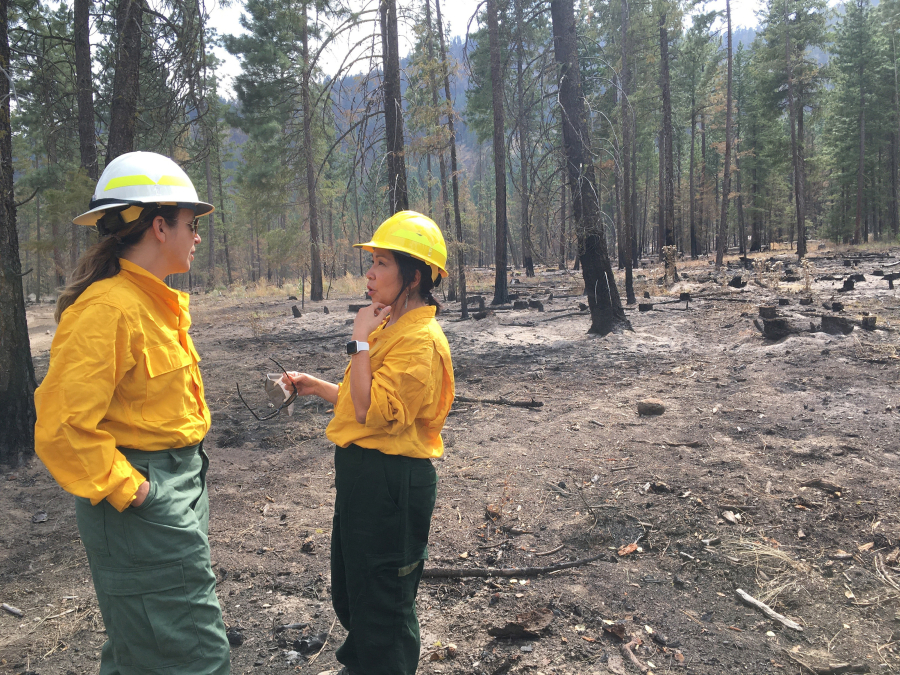WENATCHEE — Despite an anticipated hotter and drier year, state and local entities expect to be able to tackle the wildfire season with more resources than ever.
“It’s going to be pretty tough,” said Hilary Franz about this year’s wildfire season — her fifth as Commissioner of Public Lands for the state Department of Natural Resources.
She added, “That being said, we’ve done a lot to get very well prepared for it. We have more resources than we’ve ever had.”
The state Department of Natural Resources (DNR) has under their “exclusive” disposal 37 aircraft positioned throughout the state ready to respond to wildfires.
The goal: keep 90% wildfires on DNR land below 10 acres. “We’d like to do even better than that,” she said.
Over the past few years, despite an increase in the number of fires, longer fire seasons, and more land impacted by fires, DNR has been able to keep their goal with 94% of fires staying at below 10 acres.
Franz accounts that success on the amount of increased air resources.
This year’s fire season has not started as early as it did in 2021 when the state was experiencing a statewide drought. The state has experienced a lot more rain and snow in the winter and spring along with colder temperatures, according to Franz.
The weather is expected to stay hot through November, she said. And it only takes a week or so of hot, dry weather for the fuel to dry out despite all the moisture earlier in the year.
Wenatchee Valley Fire Department Chief Brian Brett said that the Wenatchee Valley area has been “pummeled with wildfires nonstop” since 2014, with the exception of 2019 and 2022, which were “slow season(s).”
But the area’s partnership with DNR has been “better than ever,” he said.
Whether its resources, manpower or equipment, Franz said she’s confident in the DNR’s ability — as well as local entities ability — to respond quickly and efficiently to fires.
Even the legislature, back in the 2021 session, approved $125 million every two years towards wildfire response.
The one, major concern remaining is people out on the landscape. About 85% of fires on DNR land is started by humans, Franz said.
“It’s people getting out and enjoying a summer vacation,” she said. “We’re urging people to do their part and be one less spark out there.”
One other preventative measure that the area would benefit from is landscape treatment after a fire does pass through the area, which the fire department is working on, Brett said.
The idea would be to plant a more fire resilient native species of shrub around structures shortly after a fires passes through. The issue, however, is that the environmental review process lasts longer than the short window of opportunity to plant the fire resilient shrub.
“We just need to get streamline that process so we can take advantage of the programs the commissioners put in place to turn over our landscape around the structures with a more fire resilient native species,” he said.
One major concern in recent years, especially in the Wenatchee Valley, has been lingering smoke from wildfires. Chelan and Douglas County commissioners last year expressed their concern on several occasions at public meetings last year.
Last year, smoke from several fires persisted through October. The air quality in late September through early October last year was the worst since 2014.
The Bolt Creek Fire near Skykomish burned more than 14,000 acres last year on federal land and poured smoke into Western Washington. Franz said the DNR has communicated with U.S. Forest Service over how the fire.
Franz also noted the unique difficulty fighting the Bolt Creek Fire for both aircraft and firefighters on the ground.
“I remember specifically sending our air resources quickly got them out, and they had to turn back because the smoke prevented and you also had steep topography, so steep topography, smoke got captured right in that space,” she said. “But in some cases, if the smoke is so bad, or that topography is extremely dangerous, you do have to let parts of those fires burn until you can get your aircraft into it.”
But between the state and local fire districts, fire crews work together better than ever, Franz said. As opposed to pre-2017, when communication was slow between the state and local entities, they’ve been able to expedite the process of attacking fires faster than ever, she said.
Franz said that no season will ever be an “easy one,” but she’s confident they’re prepared.



